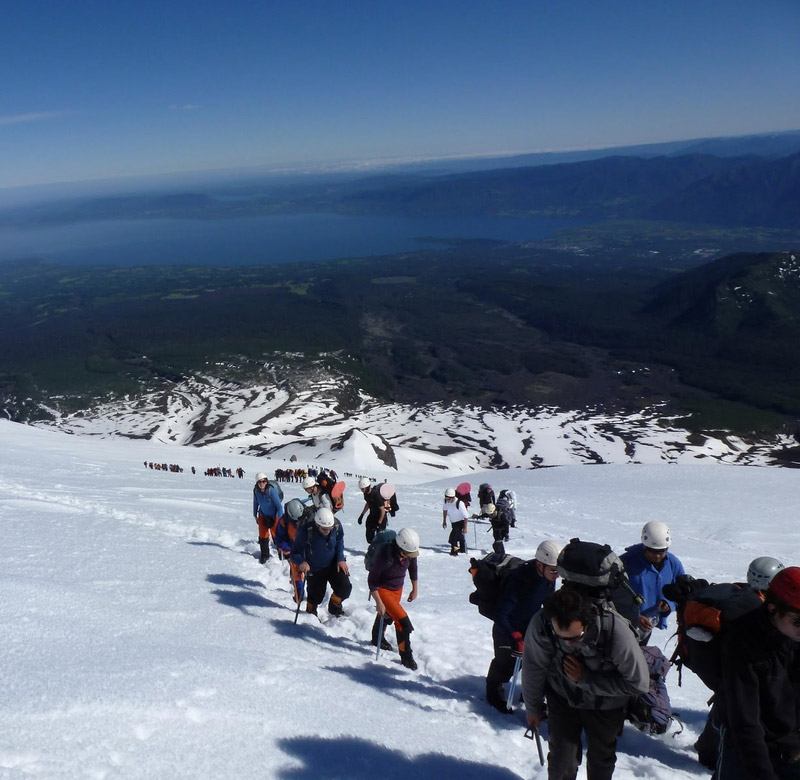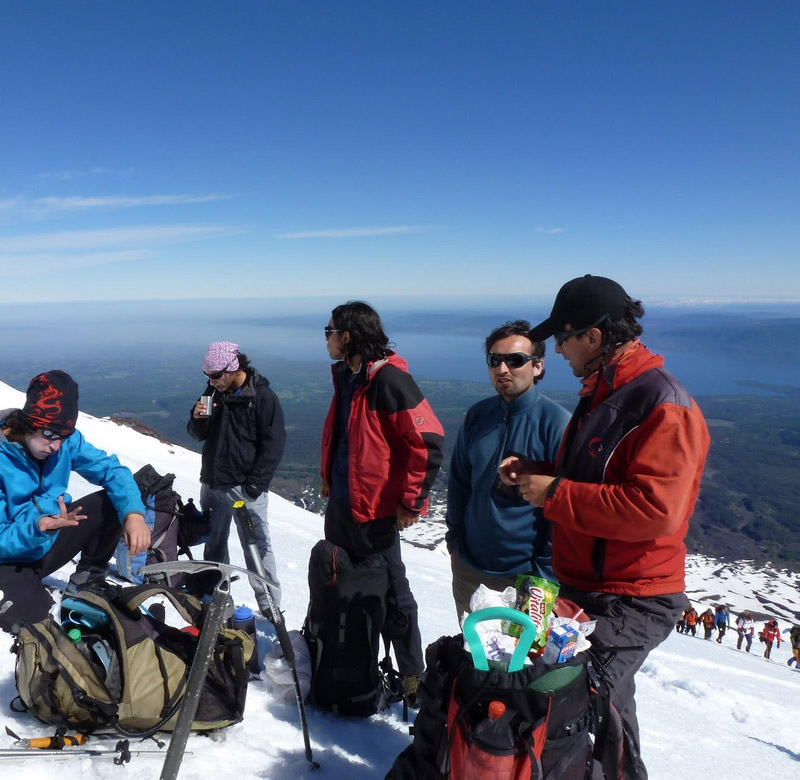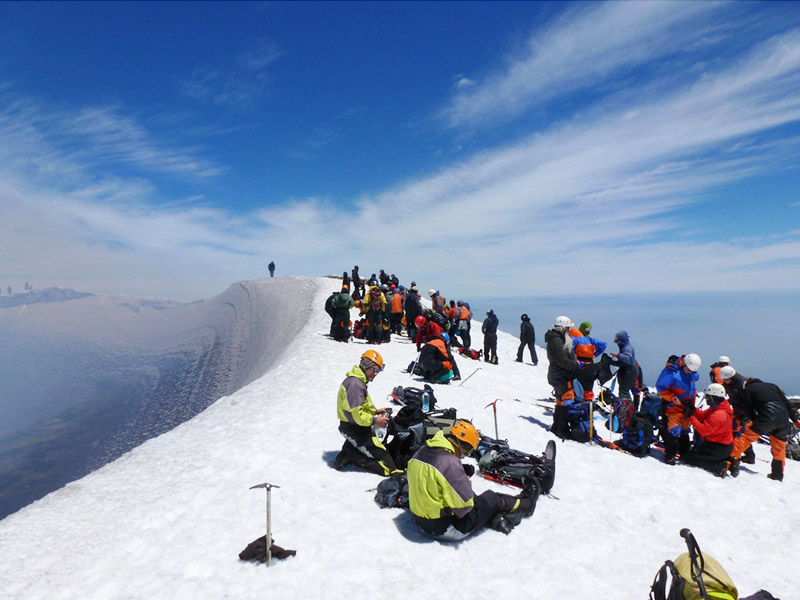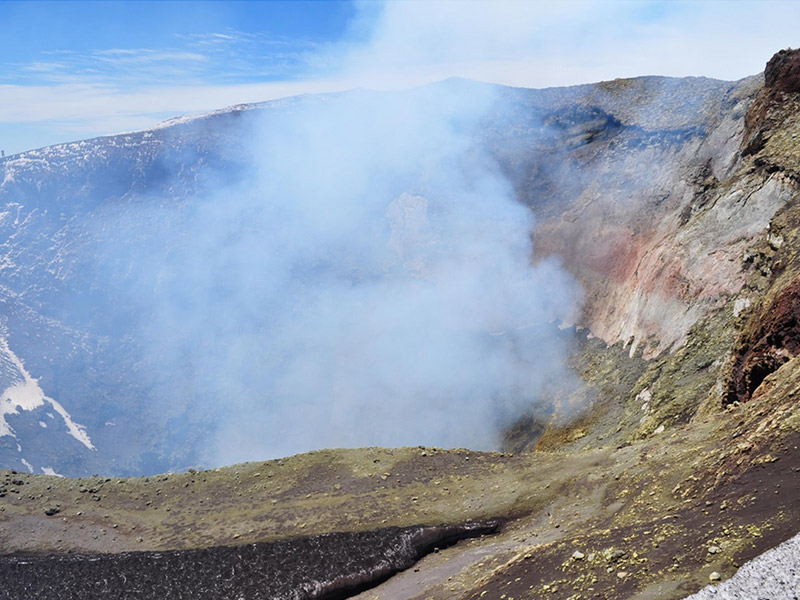

In early December 2011, I had arrived, with my wife and another couple, in Pucón, a small lakeside recreational village nestled in the Andes in southern Chile. We had travelled overnight by bus from Santiago to spend about a week absorbing the sights and adventures of Pucón. After travelling for a month in Argentina, we were enjoying spring in the southern hemisphere. Picture Vancouver in May with its mild climate and bursts of colour. Everything was in bloom. The breezes were fresh, alternating between warm and brisk. Perfect weather for sight-seeing and more.
My hiking and mountaineering buddy Steve and I were here with our wives for a vacation, but our goal was to climb the looming symbol of Pucón: the Villarrica Volcano. As we toured the town, the enormous snow-covered volcano dominated our view. At 9400 feet it towered 8700 feet over our lakeside hotel on Lago (or Lake) Villarrica. Framed by a verdant spring growth of leaves and flowers, Villarrica was both breath-taking and ominous—a challenge for Steve and me to conquer another memorable summit.

Villarrica Volcano from Pucón
After three days of waiting for the perfect weather, I was awake at 5:00 a.m. to begin the adventure. I hurriedly ate two energy bars and drank a quick cup of instant coffee (Starbucks Via) in my hotel room. Steve and I were to marshal at the mountaineering guiding company at 6:00 a.m. The sense of pending adventure stimulated me but, at the same time, a sense of apprehension, and maybe fear gripped me. Am I in good enough physical shape? Have I got all the clothes and equipment I need? Will my body’s physiological functions occur quickly, so I feel ready for what was ahead? I had to put these questions to the back of my mind as we met up with our excursion guides.
The 6:00 a.m. marshalling scene in downtown Pucón was brimming with activity. Steve and I were part of our outfitter’s group of 20 potential climbers and 10 guides. The outfitters had three mini-buses parked beside piles of mountaineering gear. Shouts of imperatives in Spanish, stray dogs barking, engines warming up, and last minute roll-calls created a clamour that heightened our excitement. We had all been issued our mountaineering gear that included boots, gaiters, pants, jackets, hiking poles, ice axes, crampons, helmets, and gas masks. Gas masks because the mountain was an active volcano that constantly streamed smoke and steam. If we managed to summit, the wind could shift the rim’s acrid gas cloud of dust particles that is dangerous to inhale. We had rehearsed how to use all this equipment. While Steve and I were seasoned climbers, most of the adventure tourists had never been on a big mountain, let alone attempted to climb it in one day. After driving for nearly an hour, we reached the base of the snow-capped volcano where we met up with other outfitters and their climbers.
Not a cloud in sight. While it was cool by the ice field’s edge, the clear day and bright sun reminded me that glaciers can produce an intense heat. Once, while climbing a glacier, I had worn a shirt with mesh at the armpits. Gradually, my chafed armpits became sore, and I realized that the sun’s reflecting rays were beaming off the snow onto my underarms causing sun-burnt armpits. On this day in Pucón, I had extra sunscreen.
I was intimidated by the scene at the marshalling point. I started being concerned about my fitness when I noticed that the assembly now totaled 200 climbers and their 100 guides. And all were much younger than Steve and me. I remember hearing the ratio of clients to guides was mandated by law to be one guide to each two climbers which gave me some reassurance that I would get help if I needed it. I tend to worry too much in situations like this, but maybe I had something to worry about. At 72 years of age, I was clearly the oldest guy on the mountain by a huge margin: I was more than 40 years older than the average climber! Everyone treated me with reverence and kindness, but likely with some skepticism because of my age.
By 7:30 a.m. we were underway. We began our ascent in a long line that wove along the base of the volcano. At times it was a challenge to stay attached to our group although each outfitter’s climbers had their own distinctive colour of helmet for easy identification. Since the slopes of volcanoes are concave, like the inside of a bowl, at the beginning of the climb, the slope was gentle; but near the top, while it is still concave, it becomes precipitous. We had about 5000 feet of elevation to climb, and our outfitters had told us the ascent would take 5 hours. This didn’t seem too much of a challenge because in our mountaineering circles 1000 vertical feet per hour is a rate of climb that I had done many times in the last 15 years. Along with the skills required for mountaineering, I knew that physically and mentally I was trained and experienced. In retrospect, maybe I was over confident; also, I was careless about not doing things that I know are critical.

Climbing at Start of Snow Field
After 3 hours of plodding upward and after a few short stops, I began to slow. Our professional mountain guides began to pay more attention to me. The head guide assigned a charming young man named Juan Peron to attend exclusively to me. (We called him JP for short.) He was attentive, sympathetic and, above all, professional. It was his job to get me to the top.

Our Guides (JP in Toque and Blue Jacket)
After 4 hours I hit a figurative physical wall: my body refused to put one foot in front of the other. I couldn’t understand what was wrong. I had done this type of climb many times under what I thought were worse conditions. After all, 5000 vertical feet on Villarrica is only twice as much as the North Vancouver’s Grouse Grind, which I had been doing in 80 minutes in recent years. But I knew I was in trouble this day.
Steve noticed my difficulty and stayed by me. He was in his late fifties, so his fitness level and strength surpassed mine. We had been climbing together for years, and had been tent mates many times on glaciers; he always looked out for me. On our climbs, against my protests, he was usually out front breaking trail more than his share. I could rely on his steady, calm nature. This day, he could see I was in trouble, so he hung back with JP and me, a silent gesture of support.
Through the fog of exhaustion, the thought entered my head that I had failed to adequately feed and hydrate my body. I knew from my experience, and the wealth of advice from mountaineers much more experienced than I, that the problem and stress I faced was because I had neglected to take the basic precautions to eat and drink sufficiently. In the rush of marshalling, I got carried away with the hustle and didn’t prepare myself well.
Physically, I had allowed myself to run out of fuel. At each rest stop I should have eaten energy bars that would provide 20% protein, 20% fat, and 60% carbohydrates, providing me with short, medium and long term sustained glucose to fuel my muscles. Also, while carrying 2 liters of water, I had not consumed a whole lot. Was I saving it for another occasion? As any athlete (which I’m not) knows, appetite and thirst disappear when you work and sweat hard, exactly when you need food and drink the most.
The lack of fuel was one of the components that caused my body to stall. Combine that with the extreme strength of the Chilean spring sun and the elevation (8000 to 9400 feet), and I should have predicted this result. The heat, the sweat, the heavy breathing—all contributed to my dehydration. Adding to my distress was the weakening of my physical condition over the previous months as I prepared for our big trip to South America. Furthermore, the last three or four weeks of over-indulging in the wonderful Argentine food and wine had not built muscle and stamina. I was not well prepared for Villarrica.
So now what? For the first time I could ever remember, was I going to admit defeat? Embarrassing. Not a good story ending. How do I push myself to move forward?
I took some time to think this dilemma through. It was 5 hours since I had eaten my energy bars in my hotel room. I had nibbled very little since, and I had consumed only one liter of my two liters of water. So I told JP I needed a stop for recovery. I forced myself to eat nuts and energy bars, and to drink water. After cooling myself with snow and applying fresh sunscreen, I started talking to myself. I repeated, ‘You can do this’ until I actually believed it. I reached into my kit of mountaineering experience and utilized the mental dimension of climbing.
As I focused on repeating, ‘You can do this. You know you can do this,’ my feet began to climb. JP was also encouraging me: ‘No está lejos; sólo 100 metros más.’ I saw several thirty-year-olds pass me on their way down: they never made it to the summit; the heat and the steeper elevation had become too much for them. I was determined to keep facing forward and to pace myself. I started counting steps until I reached 100. After a short rest to reduce my heart rate, I counted another 100 steps. Then another. After an hour of this mind-numbing self-talk, we were getting closer to the summit. The wind had blown away the snow, and the volcanic rocks started to show. The smell of sulfur, although normally unpleasant, heralded an end to the climb. We reached the top of the volcano where I rejoiced that my physical and mental conditions were recovered. The crisis had passed.

Climbers on Top of Villarrica

Looking into The Cauldron
As I marveled at the view of the Andes mountain peaks, I reveled in what I call the eighth dimension of hiking and climbing. I call it self-actualization, a term borrowed from American psychologist Abraham Maslow’s hierarchy of needs. His theory of needs explains what motivates us. The need to reach the summit had motivated me that day. I experienced the reward of utter joy in my achievement after working hard for an objective finally won.
At the top of Maslow’s pyramid of human needs is self-actualization. His famous quotation ‘What a man can be, he must be’ explains a person’s ability to recognize and then realize their full potential. On this day, the oldest guy on the mountain had realized his full potential and made the summit.
The two cardiologists who had installed two stents in my heart 12 years before would have been proud of their work.
When we returned to base camp, my guide JP pointed to his head: ‘You old guys, you got it up here. You’ve got it in your head.’ He was referring to the mental dimension of hiking and mountaineering which is discussed in Chapter 8 of this book.
Why do people climb mountains? George Mallory, the great mountaineer who died attempting Mt. Everest in 1924, said ‘Because it’s there!’ That’s a great sound bite and even today would make a catchy newspaper or TV headline. My answer typically would be more complex, and consequently, much longer.
My answer to the ‘why’ question is eight-fold (believe it or not). Hiking and climbing have eight dimensions or benefits.
- The ‘physical’ dimension (or benefit): To tackle serious hiking or climbing you need to be physically fit to grind to the summits. Auxiliary benefits include life enriching health, muscle conditioning, and a feeling of wellbeing, especially important in senior years. Enjoyment of senior years diminishes if you are overweight or sedentary.
- The ‘technical’ dimension: Beyond fitness, you need to acquire some knowledge and to develop skills relating to: outdoor clothing, climbing gear, body warmth, mountain dangers (eg. glacier travel), rescue methods, and how not to get lost.
- The ‘mental’ dimension: The incident on Villarrica is a perfect example of psyching yourself into accomplishing what some might think impossible. This entails pacing yourself to be able to keep going. I have said many times: I can do hikes in my 70s that I never could have done when I was 30.
Every mountain hiker, climber, and marathoner knows that self-talk and mental discipline are what keep you going.
- The ‘social’ dimension: Golf is sometimes characterized as a social occasion, a time to chat with friends or business associates. Hiking and climbing provide even greater opportunities to socialize with friends. Besides, I never walk so fast that I can’t carry on a conversation. This principle is a given in my hiking groups.
- The ‘nourishment’ dimension: Libraries are full of books proclaiming what to eat and drink to prepare and maintain your body for peak performance. You need to maintain strength, not get dehydrated and, for sure, not eat anything that makes your digestive system uncomfortable after prolonged exertion.
- The ‘ecological’ dimension: When we learn about our natural environment and then experience its splendor through observation, the result is a profound appreciation for nature. I frequently say, ‘the more you know, the more you appreciate.’ A trail or mountainside provides a golden opportunity to learn about geology, botany, birds, ecology, hydrology, weather patterns, flora and fauna. Your education can expand to include all the sciences related to natural history. I learn from reading and from sharing knowledge with other hikers.
- The ‘spiritual’ dimension: While my fellow hikers and climbers are secular in their world views, a hike in a forest or on a mountainside can’t help but make one reflect on our human place in nature, religion, and our escape from urban pleasures and pressures. The natural landscape generates a feeling of awe and inspires awareness of the breathtaking beauty around us. Thankfully, we can capture that scene in memory or pixels. Imagine snow-shoeing into an alpine tree-lined meadow after 30 cm of fresh snow has fallen. The stirring of these thoughts and emotions are part of what makes us human.
- The ‘self-actualization’ dimension: How does one explain the feeling of pure elation when reaching a summit after a long, arduous effort? The emotion arises from that sense of accomplishment after succeeding at something you’ve worked hard to achieve. As we wipe the sweat from our eyes, my fellow climbers and I almost always say, ‘We did it!’

My Moment of Self-actualization at the Villarrica Summit
The accomplishment of reaching a summit gives us bragging rights. We stand taller among our friends and associates. Afterward, when I view the peak from a distance, I am reminded of my experiences on that mountain. For example, every time I drive Highway 99 along the section from West Vancouver to Whistler, I recall the 48 hours I was storm bound in sleet and snow on Tantalus Mountain—the highest peak you can see from Cheakamus Lookout. That story is told in Chapter 4.
The purpose of this book is to encourage people in (or approaching) retirement to set the bar high—aim for a fully satisfying and fun-filled 30 years. It’s never too late (or too early) to learn how to hike in the hills or climb mountains. The pay-offs derive from the eight dimensions I have introduced, each of which warrants a chapter in this book.
Retirement typically means transitioning from an all-consuming work life to a world with time for new pursuits. My belief is that these new pursuits need to be both physical and mental, both social and spiritual. ‘Life is not measured by the number of breaths we take, but by the moments that take our breath away.’
Modern retirement, with medical technology, usually means 30 years of a human life, which is a long time to plan for. This book is all about not wasting those years. Walking and hiking in nature is available to everyone. Climbing mountains can also be available to many.
I hope by telling my story, you will be inspired and motivated to enrich your retirement years.
To understand my transitions from formative childhood years to university; from young forest engineer to corporate executive; from President and CEO to an active retirement that has included learning, staying fit, being challenged, achieving, and experiencing self-actualization, I want to start at the beginning—my childhood years in a small community in the East Kootenays of B.C.
As I look back at these phases of my life, I have come to recognize how each phase built on earlier phases. My childhood likely set the stage for a successful career, just as my corporate management years set the stage for my plunge into retirement. At every stage, I sought stimulation through learning, meeting challenges, and gaining rewards from achieved success.